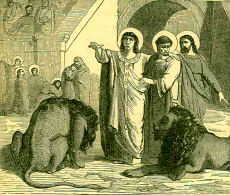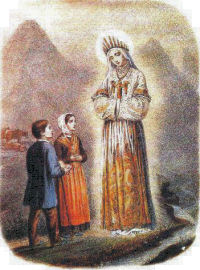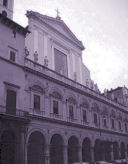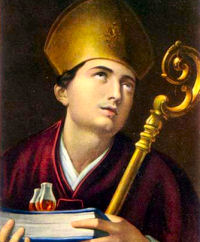Ordinary Time: September 19th
Optional Memorial of St. Januarius, bishop & martyr
Other Commemorations: Our Lady of La Salette ; Other Titles: St. Gennaro
» Enjoy our Liturgical Seasons series of e-books!
Little is known about St. Januarius. He was Bishop of Benevento in Campania. He died near Naples, about the year 305, martyred under the persecution of Emperor Diocletian. Around the year 400 the relics of St. Januarius were moved to Naples, which honors Januarius as a patron saint. He supposedly protected Naples from a threatened eruption of the volcano Mt. Vesuvius. The "miracle of Januarius" has world-wide fame. At least three times a year—on his feast day, December 16 and the first Sunday of May—the sealed vial with congealed blood of the saint liquifies, froths and bubbles up. This miraculous event has occurred every year, with rare exceptions. Popular tradition holds that the liquefaction is a sign that the year will be preserved from disasters. (In 1939, the beginning of World War II, the blood did not bubble up.)
St. Januarius
 Together with his deacons Socius and Festus, and his lector Desiderius, Januarius, bishop of Beneventum, was subjected to most atrocious torturing during the Diocletian persecution (about 304). Nevertheless, with God's aid they were preserved unmaimed. The wild animals let loose upon them would not attack. Beheaded at Puteoli, their bodies were reverently interred in the neighboring cities. Eventually the remains of St. Januarius became the prized possession of the city of Naples.
Together with his deacons Socius and Festus, and his lector Desiderius, Januarius, bishop of Beneventum, was subjected to most atrocious torturing during the Diocletian persecution (about 304). Nevertheless, with God's aid they were preserved unmaimed. The wild animals let loose upon them would not attack. Beheaded at Puteoli, their bodies were reverently interred in the neighboring cities. Eventually the remains of St. Januarius became the prized possession of the city of Naples.
"Even to the present time the blood of the saint that is preserved in a glass vial will become fluid shortly after it is brought close to the head of the saint; then it bubbles up in a remarkable manner, as if it had just been shed" (Breviary). Cardinal Schuster makes this statement in his Liber Sacramentorum (vol. 8, p. 233): "The author has seen the marvel of the blood liquefaction at closest range and can give witness to the fact. Taking into consideration all the scientific investigations that have been made, he would say that a natural explanation of the phenomena does not seem possible."
—Excerpted from The Church's Year of Grace, Pius Parsch
Patronage: patron of Naples, Italy; blood banks; volcanic eruptions
Symbols and Representation: heated oven; two red vials on Bible; bishop's mitre (headdress); palm frond (symbol of martyrdom); crown (of martyrdom)
Highlights and Things to Do:
- Find out more about this "miracle of Januarius," including photos.
- Choose Italian cuisine, particularly Neapolitan for dinner. A simple treat could be Neapolitan style ice cream—ice cream made with the three different flavors (usually vanilla, chocolate and strawberry, but originally had the colors of the Italian flag: green/pistachio, white/vanilla and red/cherry) all packed together side by side.
- If you live close to New York City you can participate in The Feast of San Gennaro celebrated in lower Manhattan.
- Read more about St. Januarius:
- See some food ideas for the feast day at Catholic Cuisine.
Our Lady of La Salette
 On September 19, 1846, the Blessed Virgin Mary appeared to Maximin Giraud and Melanie Calvat on the mountain of La Salette, France. After thorough investigation the Catholic Church gave approval to the message and secret of La Salette as written by Melanie. The account was published in Lecce on November 15, 1879 with the imprimatur of Bishop Zola of Lecce. Mary's message was much the same as at Fatima, "If my people do not wish to submit themselves, I am forced to let go of the hand of my Son. It is so heavy and weighs me down so much I can no longer keep hold of it." She lamented with tears those who do not keep Sunday holy and who take the name of the Lord in vain. She indicated that if men did not stop offending Our Lord the potato crop would fail. She gave Maximin his secret which he never revealed. She then turned to Melanie and gave her a secret which Melanie revealed 30 years later only to the Holy Father, who gave orders that it was never to be revealed.
On September 19, 1846, the Blessed Virgin Mary appeared to Maximin Giraud and Melanie Calvat on the mountain of La Salette, France. After thorough investigation the Catholic Church gave approval to the message and secret of La Salette as written by Melanie. The account was published in Lecce on November 15, 1879 with the imprimatur of Bishop Zola of Lecce. Mary's message was much the same as at Fatima, "If my people do not wish to submit themselves, I am forced to let go of the hand of my Son. It is so heavy and weighs me down so much I can no longer keep hold of it." She lamented with tears those who do not keep Sunday holy and who take the name of the Lord in vain. She indicated that if men did not stop offending Our Lord the potato crop would fail. She gave Maximin his secret which he never revealed. She then turned to Melanie and gave her a secret which Melanie revealed 30 years later only to the Holy Father, who gave orders that it was never to be revealed.
Highlights and Things to Do:
- Visit online the Basilica of La Salette. Read especially the story of the apparition and the message of Our Lady.
- Find out more about the La Salette Missionaries.
- Read Pope St. John Paul II's Address to the Missionaries of Our Lady of La Salette, May 4, 2000.
- For further reading on the apparition, see:
- See also the Shrine of La Salette in Attleboro, Massachusetts.
- Read some La Salette poetry at University of Dayton and CatholicSaints.info.
- For some fun In the kitchen, try Catholic Cuisine's Mini Blueberry Galettes.
Meditation: Ember Friday in September, “Do penance”
This excerpt from Benedict Baur is based on the 1962 Missal. The current Missal does not include special propers and readings for Ember Days.
At the church of the Twelve Apostles we were absolved of our sins on Holy Thursday and received again into the community of the Church and reconciled with God. Today we assemble again at this stational church to do penance for the sins and infidelities of the last three months and to obtain pardon. We come with Magdalen, the sinner and penitent, to hear from Christ Himself the words: “Thy faith hath made thee safe; go in peace” (Gospel). “Let the heart of them rejoice that seek the Lord; seek ye the Lord and be strengthened” (Introit).
“Return, O Israel, to the Lord thy God; for thou hast fallen down by thy iniquity. Take with you words and return to the Lord and say to Him: “Take away all iniquity and receive the good, and we will render the calves of our lips…Neither will we say anymore: The works of our hands are our gods” (Epistle). Thus we are called to do penance with a contrite and humble heart and to confess to the Lord. Magdalen is an example for us. She comes to the Lord and throws herself at His feet. She washes His feet with tears, kisses them, and anoints them with the ointment she has brought with her. She comes with a heart full of shame, full of contrition, full of courage, in self-accusation and humility. She is determined to amend her life. The Lord responds to this contrition and love which He Himself through His mercy planted in the heart of the sinful woman. “Many sins are forgiven her, because she hath loved much; but to whom less is forgiven, he liveth less. And He said to her: Thy sins are forgiven thee” (Gospel). We, too, are sinners. We, too, are penitent. We come to Him in the Holy Sacrifice, when He appears in our midst. We confess to Him that we have sinned and have offended God. We accuse ourselves in the presence of His representative. We hear the consoling words: “I absolve thee of thy sins. Go in peace.” We obtain pardon in proportion to our contrition and love. “To whom less is forgiven, he liveth less.” But on the other hand, less is forgiven to Him who loves less.
“I will heal their breaches, I will love them freely; for My wrath is turned away from them. I will be as the dew; Israel shall spring as the lily, and his root shall shoot forth as that of Libanus. His branches shall spread, and his glory shall be as the olive tree, and his smell as that of Libanus…. They shall live upon wheat [the Eucharist], and they shall blossom as a vine” (Epistle). With great tenderness and charity the Lord accepts the contrite, penitent soul, as is clear from His reception of the sinner Magdalen. Simon the Pharisee is a witness against the sinner who entered and threw herself at the feet of Jesus. He says to himself, “This man, if He were a prophet, would know surely who and what manner of woman this is that toucheth Him, that she is a sinner” (Gospel). But the Lord has come in search of sinners that He may save them. He has no word of blame for Magdalen. He does not wait until He is begged before she is allowed to appear before Him. He draws her with the power of His love and grace, and He forgives her entire debt. She renounces the false gods she has served till now, and follows the Lord. She is the first of the holy women to see the risen Savior. She received special graces and becomes a great saint, whom we may all admire and imitate.
The self-righteous Pharisee, who has invited the Lord for dinner and the sinful, penitent, contrite Magdalen present a striking contrast. The Pharisee is a type of the Jewish people, while Magdalen represented those converted from the Gentiles. In the mind of the liturgy, we are the contrite Magdalen, for the first step to grace and holiness is penitence.
We give expression to our repentance when we fast on Ember days. We sanctify our fast through the celebration of the Eucharistic sacrifice. At this sacrifice we unite our fasting and penance to the suffering and death of the Lord, and we beseech God that He may be pleased with the sacrifice of our fast and make us worthy of His grace, which we expect from the Mass. This grace will lead us to the promises of eternal life (Secret).
Christians in our day seem to have lost their sense of the necessity of penance and reparation. It is therefore even more necessary to accompany the liturgy today into the house of Simon the Pharisee and learn from the example of Mary Magdalen, how to do penance for our sins. From this holy penitent we can learn to trust in the mercy of the Lord, and thus to be purified so that we may share His blessedness.
Prayer: Grant, O almighty God, we beseech Thee, that by our devout keeping of the holy observances year by year, we may in body and in soul give pleasure to Thee. Through Christ our Lord. Amen.
—from The Light of the World, Volume Three by Benedict Baur, O.S.B.

Ember Friday of the Autumn or September Embertide
Station with Santi Dodici Apostoli (also Santi Apostoli, the Twelve Holy Apostles):
Traditionally, this is the place where the Romans choose their candidates for priesthood (Rite of Election). It was erected by Julius I (337-352) over the barracks of ancient Rome's firemen and entrusted since 1463 to the Conventual Franciscans. Originally dedicated to the Apostles St. James and St. Philip, it was rededicated to all the Apostles in the 16th century.
The Church leads us today to the "the twelve apostles," on whom the Lord conferred His power to forgive and retain sins. Bearers they are of those precious keys that open the merciful heart of God as well as the contrite heart of man, uniting the latter to the former by means of the cleansing and sanctifying blood of Jesus Christ. This Ember Friday is an appropriate occasion for giving our weekly "Friday-abstinence" a new spirit. So often we observe the day thoughtlessly—perhaps even reluctantly....Give your soul a new direction by a fruitful "ember confession." The sacrament of penance is the sacrament of liberty which frees us from the disgracing chains of our sins. True humility and sorrow are oil from the Holy Spirit which make the "keys of forgiveness" turn with heavenly smoothness. "Remove from me reproach and contempt, because I have sought out Thy commandments, O Lord; for They testimonies are my meditation."
For more on Santi Dodici Apostoli, see:
For further information on the Station Churches, see The Stational Church.






